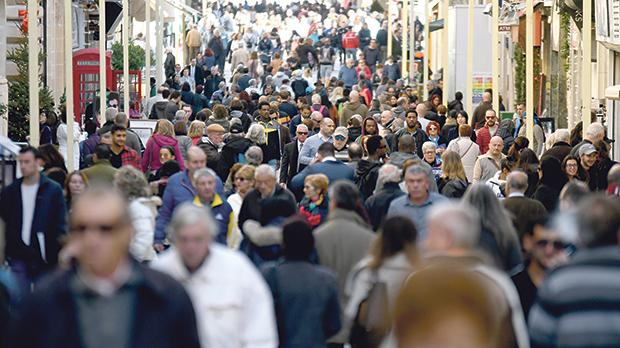When the EU Commission published an infographic on unemployment figures in Europe, with Malta topping the list with just 2.4%, many would have interpreted it as evidence of economic health, but the reality is a little more nuanced.
While on paper, Malta has the lowest unemployment rate in the European Union, the figures must be seen in the context of the intricate dynamics of Malta’s labour market, including the impact of extremely high public sector employment.
The unemployment graphic published by the EU Commission is based on Eurostat data for December 2023, which tallies with the monthly data collected by the National Statistics Office (NSO).
Furthermore, according to the latest data published by the NSO, registered full-time employment increased by 7.3% to 275,369 in August 2023.
Out of those employed, the number employed in the public sector is around 18%, equating to some 51,375, higher than the EU average of 16%.
EU unemployment in December 2023:
🇲🇹2.4
🇵🇱2.7
🇨🇿2.8
🇩🇪3.1
🇳🇱3.6
🇭🇺4.2
🇸🇮4.2
🇧🇬4.3
🇮🇪4.9
🇩🇰5.0
🇷🇴5.4
🇱🇺5.5
🇦🇹5.6
🇧🇪5.7
🇸🇰5.8
🇪🇺5.9
🇨🇾6.1
🇪🇪6.3
🇱🇹6.3
🇭🇷6.4
🇱🇻6.6
🇵🇹6.6
🇮🇹7.2
🇫🇷7.3
🇫🇮7.4
🇸🇪8.0
🇬🇷9.2
🇪🇸11.7via @EU_Eurostat ↓
— European Commission (@EU_Commission) February 4, 2024
Eurostat data for 2020 also describes how Malta experienced the most significant decline in the share of government employees in the workforce in Europe over the last two decades.
The rapid growth of private-sector employment in recent years may account for this sharp decline in public sector jobs, which now accounts for a smaller share of total employment than at any point in the past decade.
Data analysis by The Shift shows how, over the last decade, the percentage of foreign workers amid the 300,000-strong workforce increased from 10% in 2013 to almost 33% by the end of 2022, adding another layer of complexity to the figures.
According to the data, by mid-2023, the government and Maltese businesses employed more than 100,000 foreign citizens, comprising 37,000 from the EEA and more than 67,000 third-country nationals (TCNs).

Data visualising the number of public sector employees in the EU in 2020. Source: Eurostat
Public, private and vice versa
Still, precise data covering all forms of government employment is difficult to obtain, with different data covering different public authorities or bodies within the public sector.
Complicating our understanding of the data further is that the government employs over 5,000 contract workers from the private sector in the public administration on top of the 51,000 employees it currently has.
Partial data collected and analysed by The Shift through various parliamentary questions submitted by Nationalist Party MP Ivan Castillo shows that in 2023, several ministries will have employed around 5,200 additional people through outsourcing to private companies, swelling the size of the public sector to over 56,200.
This data is only the tip of the iceberg, as some ministries, especially those that generally generate the highest employment needs, such as the health ministry, are yet to provide their data.
According to the information, the Ministry for the Elderly, when led by Jo Etienne Abela, has about 2,270 additional private sector employees directly on its payroll, followed by Miriam Dalli’s environment ministry with almost 1,000 more.
Throw in a ‘jobless’ scheme
The figures can also be inflated by including another 1,200 ‘jobless’ persons working for the government through the Community Workers Scheme (CWS).
Like the government’s contract workers, those on the CWS are also considered part of the ‘private sector’ as their official employer is a foundation owned by the General Workers Union, which was given a multi-million tender to administer this scheme on behalf of the government.
This scheme was criticised by the National Audit Office (NAO) as a way to keep national unemployment figures low by having people seeking work shifted onto the scheme.
The report noted how “Every effort needs to be undertaken to ensure that this Scheme produces the desired outcomes, namely that improvements are made in the applicants’ employability skills, rather than it ending up simply as a numbers exercise whereby persons are just struck off from the unemployment list and shifted on to this Scheme.”
In 2021, the Malta Employers Association called for the phasing out the Community Workers Scheme and rationalising public sector employment and redeployment of excess workers to the private sector in a position paper.
The figures above, albeit partial, present a slightly different picture than what has been reported to the Commission, particularly when combined with the concerns of the NAO and Malta Employers’ Association, and require further analysis rather than being taken at face value.













The employment through the Community Workers Scheme by the GWU, is nothing less than precarious jobs.
We know that most people are ’employed’ by the government in exchange for their votes and the votes of their families. That is why we will never be rid of this parasitic government and its bloodsucking fleas. Nobody cares about us poor people held hostage here by this government having to give them all our money. The EU does nothing. It’s too late for Malta – get out while you can.
If workers employed with government agencies were also included, the figures would skyrocket.